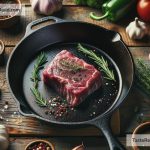Mastering the Art of Open Flame Cooking: Advanced Techniques Unveiled
Cooking over an open flame brings us back to our ancestral roots, evoking a deep sense of connection to nature and the primal thrill of taming fire to nourish ourselves. While this method is as old as time, it doesn’t mean there isn’t room for improvement and sophistication in our approach. Here, we dive into advanced techniques that will elevate your open flame cooking, transforming simple fire-based meals into culinary masterpieces.
1. Mastering Temperature Control
The key to successful open flame cooking lies in your ability to control the heat. Unlike your kitchen stove, an open flame doesn’t come with knobs for temperature adjustment. So, how do you regulate heat? It’s all about managing the coals and the distance between your food and the flame.
-
Direct vs. Indirect Heat: For intense searing, place your grill grate close to the flames. When you need to cook something slowly or thoroughly, like a thick cut of meat, use indirect heat by placing coals on one side of your grill, leaving the other side without. Place your food on the coal-free side, allowing it to cook evenly without burning.
-
Coal Management: Hardwoods create intense and long-lasting coals ideal for cooking. Distributing coals evenly or in specific patterns can help you create ‘zones’ of different temperatures on your grill.
2. Embracing the Smoke
Smoke is an ingredient in its own right when cooking over an open flame. Different types of wood can impart unique flavors to your food. Hardwoods like oak, hickory, and maple provide rich flavors, while fruitwoods like apple and cherry deliver a sweeter, more mellow taste.
To infuse your dishes with a deep smoky flavor, consider these techniques:
– Wood Chips: Soak wood chips in water and sprinkle them over your coals to produce a fragrant smoke that can give an extra layer of flavor to your meat or vegetables.
- Smoking Pouches: Create small pouches out of aluminum foil filled with soaked wood chips. Poke holes in these pouches to allow smoke to escape, and place them directly on the coals.
3. Utilizing Aromatics
Incorporating aromatics like herbs, onion, garlic, and citrus peels into your coals can subtly enhance the flavors of your grilled dishes. The heat will release essential oils from these ingredients, infusing your food with their essence.
4. Cast Iron Cooking
Don’t limit your open flame cooking to grilling alone. Cast iron pans and Dutch ovens are incredibly versatile tools for open flame cooking. These sturdy vessels excel at evenly distributing heat and can be used to bake, roast, or simmer a variety of dishes over an open fire.
-
Baking on Coals: You can bake bread, pizzas, and even cakes in a cast iron skillet by placing it on coals and covering the lid with more coals for even heat distribution.
-
Slow Cooking and Stewing: Dutch ovens are perfect for making soups, stews, or even chili over an open fire. The thick walls and tight-fitting lids help maintain a steady temperature, ensuring your food is cooked to perfection.
5. Rotisserie Cooking
Rotisserie cooking involves slowly rotating meat over a fire, allowing it to cook evenly and self-baste, resulting in exceptionally juicy and flavorful meat. While a bit more labor-intensive, setting up a makeshift rotisserie over your fire can elevate your cooking game to new heights.
6. The Art of Skewering
Skewering isn’t just for kebabs. By using different materials for skewers, you can add extra flavor to your dishes. For example:
– Rosemary Skewers: Strip the leaves from rosemary branches, leaving a few at the end for decoration. Use these as skewers for meat or vegetables for a subtle, herby flavor.
- Lemongrass Skewers: Similar to rosemary, lemongrass stalks can be used as skewers. The lemongrass imparts a fresh, citrusy flavor, perfect for seafood or chicken.
Wrapping Up
Fire cooking is not just a method; it’s an art form that has been refined over millennia. By understanding and applying these advanced techniques, you can transform the simple act of grilling over an open flame into a culinary adventure, creating dishes that are not only delicious but deeply satisfying to prepare. So, the next time you light up that fire, remember these tips and let your culinary creativity soar.


